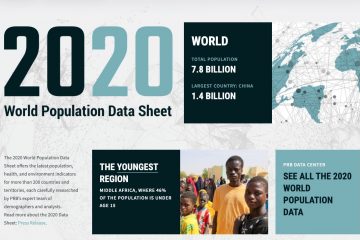
9 Billion World Population by 2050
(June 2000) The current period of rapid population growth will continue for at least another 50 years, according to the 2000 World Population Data Sheet of the Population Reference Bureau. By 2050, the world is expected to add 3 billion more people to reach a total of 9 billion.
“Just last October, global population passed the six billion mark,” said Carl Haub and Diana Cornelius, authors of the annual report card on world demographic trends. “And now we are well on our way toward a seventh billion in only 12 or 13 years, the shortest period ever. But this scenario assumes increasing use of voluntary family planning in developing countries, even in areas where it is virtually unknown.” At stake are the success of efforts to protect the environment, combat growing poverty, and solve water and food supply problems.
The less developed countries of Africa, Asia, and Latin America now account for 80 percent of world population, but represent 99 percent of global growth. The highest growth rates are found in the poorest countries, despite stated policies to reduce population growth and despite high levels of HIV/AIDS, particularly in sub-Saharan Africa.
World population in 2000 totaled 6,067,000,000 (6.1 billion) with 1,184,000,000 living in the more developed countries (Europe, North America, Australia, Canada, and New Zealand) and 4,883,000,000 in the less developed countries of Africa, Asia, and Latin America.
Worldwide, women currently average about 2.9 births in their lifetime. This ranges from a low of only 1.2 in Eastern Europe to 5.8 in sub-Saharan Africa.
The population of less developed countries (excluding China) now numbers 3,619,000,000. The bulk of world population growth is concentrated in these countries (70 million annually).
In these countries, women average 3.7 children each, a rate well above the two children required for populations to only “replace” themselves and reach a condition of zero growth.
Other highlights from the 2000 World Population Data Sheet:
- India became the world’s second population billionaire this year and is expected to pass China by midcentury.
- Globally, about 1 percent of the population is estimated to be infected with HIV/AIDS. The highest proportion is in sub-Saharan Africa (7.1 percent) and the lowest in Europe (0.2 percent) and Oceania (0.1 percent).
- Sub-Saharan Africa, with a population of 657 million and a total fertility rate of 5.8 children per woman, has by far the fastest growing population of any major region in the world. The HIV/AIDS epidemic notwithstanding, the region is projected to have 1.5 billion inhabitants by 2050.
- Europe, in sharp contrast to the developing world, continues its population decline. As developing-country populations expand and Europe experiences demographic decrease, Europe in 2050 will account for only 7 percent of the world’s population, down from 12 percent today.
- Russia’s population is projected to decline from 145 million to 127 million by 2050, a result of record-low fertility in that country.
- Botswana and Zimbabwe have more than 25 percent of their populations infected with HIV/AIDS, the highest rates in the world.




